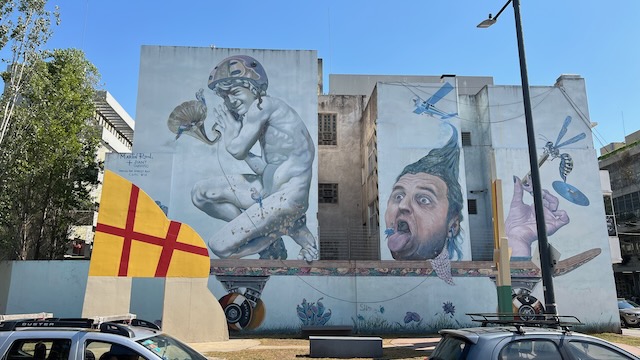One of the best ways to connect to a city is through a walking tour of its street art. By walking, you have a chance to slow down and feel the sense and rhythm of the local population. You get a chance to see the place as the locals do, complete with the sounds and smells of the city. As you pass the corner bakery, you get a whiff of the fresh croissants within. You hear the birds, the cars in the distance, and the chatter between the two old men discussing their families over morning coffee. And with a local guide, you get the quirky stories of neighborhood, the history of the buildings and the thought processes behind the art.
Is Street Art and Graffiti The Same Thing?
Street art is just a painting that is done in a public space, such as on the wall of a building or fence. It can be created to beautify an urban landscape, convey a social message, or to transform a public area. Many times it is associated with “gentrification” of an area. Artists are either locals or, such as in Buenos Aires, they are invited artists from different countries. In the Wyndwood Walls in Miami, they have taken it to an extreme and created an outdoor museum of street art.

Graffiti, on the other hand, is created by locals as a way of marking territory or making a statement. Usually the name of the person or group is the main image. Unlike street art, graffiti is created without the permission of the property owner.

In terms of style, graffiti often features stylized lettering and bold colors, while street art can take on a wider range of styles and approaches, from realistic portraiture to abstract patterns and designs. While both forms of art can be controversial, street art is often seen as more socially acceptable and can even be celebrated as a positive addition to urban environments.
Urquiza Neighborhood Street Art Tour
Urquiza is a residential neighborhood known for its tree-lined streets, large parks, and quiet, suburban feel. Some of the earliest street art pieces in Urquiza were political murals created in the 1970s and 1980s by activists and political groups. They expressed protests against the military dictatorship that ruled Argentina during that time. It has evolved since then to include scenes of nature and Argentinian culture.

In 2010, the organization “Buenos Aires Street Art” started working with local artists to highlight their talents and provide them with an income and exposure. They convinced building owners to allow them to beautify their walls with murals for free. And they lead art tours around the neighborhood, using the fees charged to fund the commissions to the artists.
The tour starts and ends at the same location. We met our guide at 10am, with a small group of 6 other people. We walked for about 2 miles, over the course of 2 hours, stopping at the most interesting of the artworks to hear the history of the piece and the artist. Along the way we learned about the area, the people, and the aspirations. We stopped for coffee and ice cream as a rest-stop. Having a local guide explain the art, the culture and the people, makes you feel more connected to the city. You get a chance to interact with someone who shares your passion for art, creating a bond that far deeper than a simple bus tour around a city. And you get some exercise, fresh air (usually), and off the beaten path.
One of the interesting things that I learned was that once an art piece is completed, it is left to the elements. It is not maintained or preserved in any way. So over time, they experience fading, decay and disappear. For this reason, I suggest you go sooner than later. This applies to all street art everywhere. It is part of the urban environment, and while new art is being created all the time, the old ones are slowly vanishing.
Having gone on this tour, I can say that it is well worth a few hours to get acquainted with the street artists of Buenos Aires.
A recommended tour is found here: graffitimundo.com.




















